Spring runoff in the Rockies and in many other parts of the country promises to be epic this year—some areas may not see perfectly fishable flows until mid-July. Nobody's complaining, mind you. A big winter will fill depleted reservoirs and buy some time for our imperiled trout.
But fishing on many rivers, particularly those that aren't tailwaters, is going to be tough until we get over the snowmelt hump. Even so, patient and crafty fly fishers can find trout in high,dirty water if they employ the proper techniques.
Here are a few tips to help you connect with high-water trout early this season.
Give Euro-nymphing a try
If you haven't figured out the intricacies and tackle differences of Euro-nymphing, runoff and high-water fishing is a good time to start. The heavier, sparser flies, long leaders and the thinner, water-slicing lines get down fast into the feeding lanes for trout, even in high and dirty conditions.
It can be particularly effective from a drift boat, where the guide behind the oars can pilot the craft along holding water that's unreachable for wading anglers. The same general rules apply, however – the idea is get the fly (or, more likely, flies) down deep quickly and then allow them to drift just a bit faster than the current is flowing. This adds tension to the line and makes it easier for the angler to detect strikes.
Under normal circumstances, in water where trout eat more often under the water than they do on top, Euro-nymphing can be downright deadly. In high and dirty water, the technique can be used to access feeding lanes that might otherwise be unreachable.
If you're Euro-curious, high water conditions offer up the perfect opportunity for some experimenting.
The mono-fluoro combo
For all it's faults, fluorocarbon leader and tippet material does one thing much better than its monofilament cousin: it sinks. And for nymphing anglers, fluorocarbon tippet coupled with mono leader can improve a long drift while helping a weighted fly dive into the strike zone sooner and stay there longer.
But this stuff is noxious. There's no way around it. Fluorocarbon leader and tippet doesn't break down in the environment. Sure, it's stronger, but every little piece of fluorocarbon tippet that's ever been fished and lost in rivers and lakes is probably still there. In time, it's likely that, like other per- and polyflouroalkyl substances (PFAS), fluorocarbon will be banned in some states and perhaps all over the country.
If you use it, use it sparingly. Discard any trimmings appropriately. It's obviously better to avoid it altogether.
Go sparse with nymphs
When you're fishing for trout in high water, simple physics is your friend. Weighted nymphs tied with fewer materials sink better and stay in high-water feeding lanes longer.
Flies like Perdigon (Spanish for "pellet" due to its heavy weight and streamlined appearance) nymphs that sport a heavy, bead head and a lacquered body dive deeper faster. Many professional fly anglers tie their Perdigons with bright "hot spots" to make the flies more visible is off-colored water.
Other flies to consider? Think Copper Johns–these nymphs are tied with wrapped-wire bodies that slice through the water and get down fast. Weighted San Juan Worm patterns, too, are great options for sparsely tied flies that perform well in high water–often, runoff eats away at riverbanks and real red worms and earthworms end up drifting haplessly downstream.
Sink-tip fly lines
If you're a streamer angler, high water can be your friend. Employing a sink-tip fly line while casting tight to the slack water near banks and behind cover, like rocks or wood, can be very effective.
To improve your odds, add weight to the streamer and consider a sparsely tied fly rather than a bulky, furry creation–again, fewer materials allow flies to sink faster and remain in the strike zone longer.
Longer leaders
For many anglers, fishing longer leaders can be challenging, but there are ways to help you with that slower cast that can allow you to use a longer leader that will sink faster and deliver your flies to the feeding lane longer.
First, consider adding a foot or more of heavy mono to the butt section of the leader rather than sizing down the tippet. This can be particularly helpful for streamer anglers where added stretches of tippet make it tougher for leaders to turn flies over.
If you're a nympher, consider adding a couple feet of lighter tippet to the end of the leader, and then using a high-floating dry fly as an indicator. Attach a heavy nymph as the lead fly–like a Girdle Bug or a weighted Prince Nymph–and then drop a second fly, like a downsized Perdigon or Copper John, from the bend in the top fly's hook.
The long leader under the indicator fly will give you that "L"-shaped drift and put two flies in the zone. That can be hugely helpful in high, dirty water.
Fish the banks
The heavy flows and turbid waters common with spring runoff will push trout out of their normal holding lies. Trout don’t want to expend precious energy to hold in a raging torrent. And, even though trout see well even in turbid water, given the choice, they’ll typically often for water with better clarity.
As we noted in the article “Why let a little high water stand in your way”, “Locating the areas in the stream where a trout will move to find slower current and better visibility isn't difficult. They are almost invariably along the banks, where boulders, trees and other obstructions break the current and provide a refuge for energy-conserving trout.”
Fish where the fish are.
Don't despair
Don't be afraid to experiment due this time of the year. While it's certainly possible that fishing will we a little slower, enterprising anglers can enjoy great fishing during runoff and high water.
And, particularly in the West, we're going to see a lot of that this spring and into summer. The only way to beat it is go fishing anyway.
Beats the alternative, right?










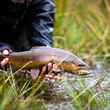





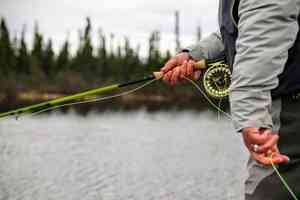

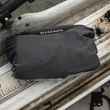
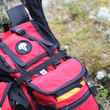
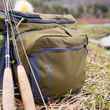



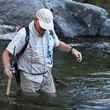
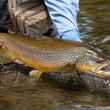



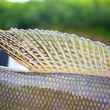
![Meagan Cook with CeCe [left] and her mother Birdie [right], the dog that started it all (Images courtesy: Meagan Cook). meagan cook dog rescue](https://www.hatchmag.com/sites/default/files/styles/gallery_thumbnail/public/field/image/meagancook.jpg?itok=3StbM11l)
Comments